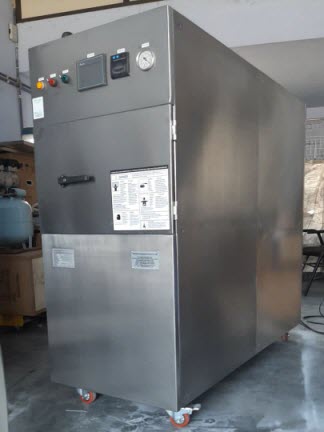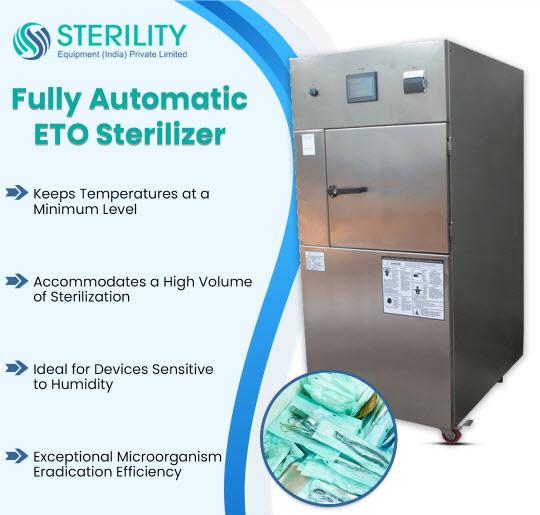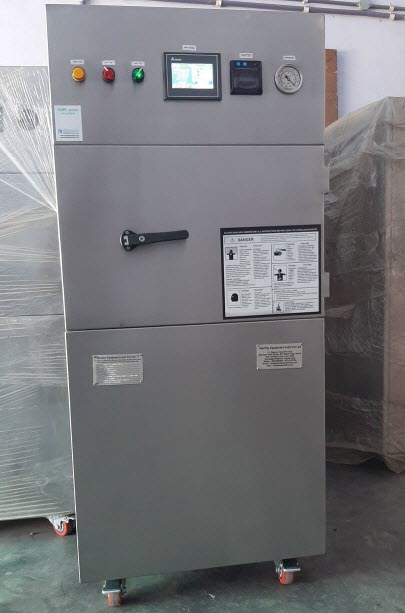In today’s world, sterilization is of utmost importance to ensure the safety and well-being of individuals. One highly effective method of sterilization is the use of Fully Automatic ETO (Ethylene Oxide) Sterilizers.
Fully Automatic ETO Sterilizer is an effective and safe method for sterilizing textile and biological materials. It can be used to sterilize biodegradable fabrics such as cotton wool chemical fiber clothing and blankets; biological products like cultural relics and gauze; and instruments and sanitary tableware. It offers five user defined cycles including Cold & Warm Cycles. Its PLC based control system ensures accurate temperature, moisture and gas injection and exposure controls.
What is a Fully Automatic ETO Sterilizer?
A Fully Automatic ETO Sterilizer is a state-of-the-art sterilization equipment that utilizes ethylene oxide gas to eliminate bacteria, viruses, and other microorganisms from medical devices, instruments, and equipment. It is widely used in healthcare facilities, pharmaceutical industries, and laboratories to ensure the sterility of various items.
Once the sterilization cycle is complete, the pressure in the sterilizer is released and the container is opened. The liquid ethylene oxide is then discharged into the air, which is vented to the outside through a dedicated vent line. The valves in the sterilizer should be checked and maintained regularly to ensure that they are working properly.
ETO sterilization is an important method for sterilizing medical and pharmaceutical equipment in hospitals and laboratories. It is also a popular sterilization technique for processing textiles and other textile-based materials, such as cotton wool clothing and woollen blankets. It is a safer alternative to steam sterilization for these types of products, as it produces less heat and doesn’t damage the material.
In addition to the risks associated with storing, handling and disposing of ETO, the pressurized design of these sterilizers can cause exposures when a failure occurs. For example, if the pressure-relief valve fails to open during the sterilization dwell period, or the vacuum purge malfunctions, it can discharge ETO into the workspace. Therefore, it is important that these machines be installed and operated in a well-ventilated area.

How does a Fully Automatic ETO Sterilizer work?
A Fully Automatic ETO Sterilizer operates by introducing ethylene oxide gas into a sealed chamber containing the items to be sterilized. The gas penetrates the packaging and reaches all surfaces of the items, effectively killing microorganisms. The sterilization process usually consists of several steps, including pre-conditioning, exposure, diffusion, aeration, and degassing, which ensures thorough sterilization while minimizing the residual gas concentration.
What are the advantages of using a Fully Automatic ETO Sterilizer?
Fully Automatic ETO Sterilizers offer several advantages over other sterilization methods. They can penetrate various types of packaging materials, ensuring the sterilization of even delicate and heat-sensitive items. Moreover, ETO sterilization is highly effective against a wide range of microorganisms, including spores. The process also does not leave behind any residue or damage the sterilized items.
Ethylene oxide sterilization (EO) is a process that kills microorganisms by breaking their DNA. It is a highly effective sterilization method for items that are moisture or heat sensitive. In addition, EO sterilization is non-corrosive to metal, plastic, and rubber materials. This makes it ideal for sterilizing medical devices, pharmaceuticals, and other healthcare products. Moreover, the low temperature of EO sterilization reduces the risk of material damage to the equipment being sterilized.
In order to ensure the safety of the equipment being sterilized, it is necessary to use an ETO Sterilizer with a high-quality control system. The control system should be able to monitor the air pressure and vacuum within the sterilizer, as well as the temperature of the chamber. It should also be able to detect any malfunctions in the system and shut down the sterilizer if necessary. In addition, the control system should be able to automatically restore the machine to the stop state after any unexpected power failures.
Is a Fully Automatic ETO Sterilizer safe to use?
When used correctly and in accordance with safety guidelines, Fully Automatic ETO Sterilizers are considered safe. However, due to the potential hazards associated with ethylene oxide gas, it is essential to follow strict protocols to protect the operators and minimize environmental impact. Proper ventilation, personal protective equipment, and adherence to regulatory guidelines are crucial in ensuring the safe operation of the equipment.

What industries use Fully Automatic ETO Sterilizers?
Fully Automatic ETO Sterilizers find applications in various industries. They are extensively used in hospitals, clinics, and healthcare facilities for sterilizing medical instruments, implants, and equipment. Pharmaceutical industries utilize them for sterilizing packaging materials, vials, and syringes. Research laboratories also rely on Fully Automatic ETO Sterilizers for the sterilization of laboratory equipment and tools. Additionally, food processing industries and manufacturers of cosmetic and personal care products may also utilize Fully Automatic ETO Sterilizers to ensure the safety and sterility of their products.
What factors should be considered when choosing a Fully Automatic ETO Sterilizer?
When selecting a Fully Automatic ETO Sterilizer, several factors should be taken into consideration. These include the capacity and size of the sterilizer, compatibility with different types of materials, cycle time required for sterilization, safety features, ease of operation, and compliance with regulatory standards. It is essential to assess the specific needs of the industry or facility and choose a sterilizer that best meets those requirements.
Are there any alternatives to Fully Automatic ETO Sterilizers?
While Fully Automatic ETO Sterilizers are highly effective, there are alternative sterilization methods available. Some alternatives include steam sterilization (autoclaving), hydrogen peroxide vapor sterilization, gamma irradiation, and dry heat sterilization. The choice of sterilization method depends on factors such as the type of materials to be sterilized, the required sterility assurance level, and the specific industry or application.

How to maintain and clean a Fully Automatic ETO Sterilizer?
Proper maintenance and cleaning of a Fully Automatic ETO Sterilizer are essential to ensure its optimal performance and longevity. Regular maintenance tasks may include cleaning the chamber, inspecting and replacing gaskets and filters, calibrating temperature and pressure sensors, and verifying the effectiveness of sterilization cycles. It is important to follow the manufacturer’s instructions and guidelines for maintenance and cleaning procedures.
What are the regulations and guidelines for using Fully Automatic ETO Sterilizers?
The use of Fully Automatic ETO Sterilizers is subject to regulations and guidelines to ensure safety and compliance. Regulatory bodies such as the Food and Drug Administration (FDA) and international standards organizations provide specific requirements for the use of ethylene oxide gas and sterilization processes. It is crucial for facilities and operators to stay updated with these regulations and adhere to them to maintain a safe and compliant sterilization practice.
Can a Fully Automatic ETO Sterilizer be used for all types of materials?
Fully Automatic ETO Sterilizers can be used for a wide range of materials, including medical devices, surgical instruments, electronic components, textiles, and packaging materials. However, certain materials may not be compatible with ethylene oxide gas or require special precautions. It is important to consult the manufacturer’s guidelines and consider the material compatibility and recommended sterilization methods for specific items.
How long does the sterilization process take with a Fully Automatic ETO Sterilizer?
The duration of the sterilization process with a Fully Automatic ETO Sterilizer can vary depending on factors such as the size and complexity of the load, the required sterility assurance level, and the specific sterilization cycle selected. Typical cycle times can range from a few hours to several hours, including the time for preconditioning, exposure, aeration, and degassing.
Are there any risks associated with using a Fully Automatic ETO Sterilizer?
The use of Fully Automatic ETO Sterilizers carries certain risks due to the potential hazards associated with ethylene oxide gas. These risks include the flammability and explosiveness of the gas, its potential toxicity to humans, and environmental concerns. It is crucial to implement proper safety measures, provide adequate ventilation, and train operators on the safe operation and handling of ethylene oxide gas to mitigate these risks effectively.





